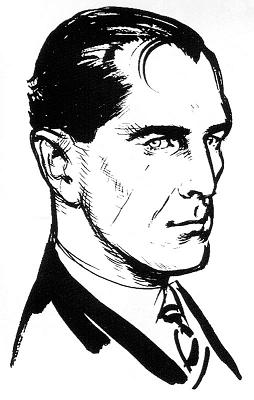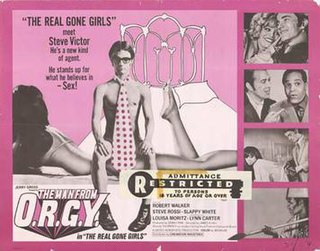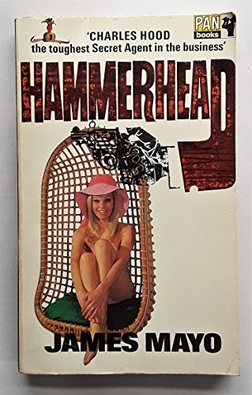
The James Bond series focuses on James Bond, a fictional British Secret Service agent created in 1953 by writer Ian Fleming, who featured him in twelve novels and two short-story collections. Since Fleming's death in 1964, eight other authors have written authorised Bond novels or novelisations: Kingsley Amis, Christopher Wood, John Gardner, Raymond Benson, Sebastian Faulks, Jeffery Deaver, William Boyd, and Anthony Horowitz. The latest novel is With a Mind to Kill by Anthony Horowitz, published in May 2022. Additionally Charlie Higson wrote a series on a young James Bond, and Kate Westbrook wrote three novels based on the diaries of a recurring series character, Moneypenny.
Spy fiction is a genre of literature involving espionage as an important context or plot device. It emerged in the early twentieth century, inspired by rivalries and intrigues between the major powers, and the establishment of modern intelligence agencies. It was given new impetus by the development of fascism and communism in the lead-up to World War II, continued to develop during the Cold War, and received a fresh impetus from the emergence of rogue states, international criminal organizations, global terrorist networks, maritime piracy and technological sabotage and espionage as potent threats to Western societies. As a genre, spy fiction is thematically related to the novel of adventure, the thriller and the politico-military thriller.
Leonard Cyril Deighton is a British author. His publications have included cookery books, history and military history, but he is best known for his spy novels.

Ian Lancaster Fleming was a British writer, best known for his postwar James Bond series of spy novels. Fleming came from a wealthy family connected to the merchant bank Robert Fleming & Co., and his father was the Member of Parliament (MP) for Henley from 1910 until his death on the Western Front in 1917. Educated at Eton, Sandhurst, and, briefly, the universities of Munich and Geneva, Fleming moved through several jobs before he started writing.

Q is a character in the James Bond films and novelisations. Q is the head of Q Branch, the fictional research and development division of the British Secret Service.

Felix Leiter is a fictional character created by Ian Fleming in the James Bond books, films and other media. The character is an operative for the CIA and Bond's friend. After losing a leg and his hand to a shark attack, Leiter joined the Pinkerton Detective Agency. The name "Felix" comes from the middle name of Fleming's friend Ivar Bryce, while the name "Leiter" was the surname of Fleming's friend Marion Oates Leiter Charles, the then wife of Thomas Leiter.

The Spy Who Loved Me is the ninth novel and tenth book in Ian Fleming's James Bond series, first published by Jonathan Cape on 16 April 1962. It is the shortest and most sexually explicit of Fleming's novels, as well as a clear departure from previous Bond novels in that the story is told in the first person by a young Canadian woman, Vivienne Michel. Bond himself does not appear until two-thirds of the way through the book. Fleming wrote a prologue to the novel giving Michel credit as a co-author.

John Edmund Gardner was an English spy and thriller novelist, best known for his James Bond continuation novels, but also for his series of Boysie Oakes books and three continuation novels containing Sir Arthur Conan Doyle's fictional villain, Professor Moriarty.

A novelization is a derivative novel that adapts the story of a work created for another medium, such as a film, TV series, stage play, comic book or video game. Film novelizations were particularly popular before the advent of home video, but continue to find commercial success as part of marketing campaigns for major films. They are often written by accomplished writers based on an early draft of the film's script and on a tight deadline.
Christopher Hovelle Wood was an English screenwriter and novelist, best known for the Confessions series of novels and films which he wrote as Timothy Lea. Under his own name, he adapted two James Bond novels for the screen: The Spy Who Loved Me and Moonraker (1979).

Dr. No is a 1962 spy film directed by Terence Young. It is the first film in the James Bond series. Starring Sean Connery, Ursula Andress, Joseph Wiseman and Jack Lord, it was adapted by Richard Maibaum, Johanna Harwood, and Berkely Mather from the 1958 novel of the same name by Ian Fleming. The film was produced by Harry Saltzman and Albert R. Broccoli, a partnership that continued until 1975. It was followed by From Russia With Love in 1963. In the film, James Bond is sent to Jamaica to investigate the disappearance of a fellow British agent. The trail leads him to the underground base of Dr. Julius No, who is plotting to disrupt an early American space launch from Cape Canaveral with a radio beam weapon.

Live and Let Die is the second novel in Ian Fleming's James Bond series of stories. Set in London, the United States and Jamaica, it was first published in the UK by Jonathan Cape on 5 April 1954. Fleming wrote the novel at his Goldeneye estate in Jamaica before his first book, Casino Royale, was published; much of the background came from Fleming's travel in the US and knowledge of Jamaica.

Commander James Bond is a character created by the British journalist and novelist Ian Fleming in 1953. He is the protagonist of the James Bond series of novels, films, comics and video games. Fleming wrote twelve Bond novels and two short story collections. His final two books—The Man with the Golden Gun (1965) and Octopussy and The Living Daylights (1966)—were published posthumously.
Stephen Coulter was a British novelist, journalist, and, as James Mayo, the author of several spy and adventure thrillers.
The following outline is provided as an overview of and topical guide to James Bond:

The Man from O.R.G.Y. is a 1970 comedy film directed by James Hill and starring Robert Walker Jr., Louisa Moritz, Slappy White, Lynne Carter and Steve Rossi. It was filmed in Puerto Rico and New York City. The film has elements of espionage and sex.
Len Deighton is an English author known for his novels, works of military history, screenplays and cookery writing. He had a varied career, including as a pastry cook, waiter, co-editor of a magazine, teacher and air steward before writing his first novel in 1962: The IPCRESS File. He continued to produce what his biographer John Reilly considers "stylish, witty, well-crafted novels" in spy fiction, including three trilogies and a prequel featuring Bernard Samson.

Mr. Grex of Monte Carlo is a 1915 spy novel by the British writer E. Phillips Oppenheim. The action takes place in Monaco, a favourite setting in the author's novels. Oppenheim was a pioneer of the modern spy genre, often giving his works a glamorous international setting. Although published in 1915, it was likely to have been written in 1914.

Hammerhead is a 1964 spy thriller novel written by James Mayo. It was the first in a series of five novels featuring the spy Charles Hood, working for British intelligence. Hood's cover is that of an art dealer, and in this case he is sent by MI6 to infiltrate the luxury yacht of a villain, moored off the French Riviera. Hood discovers a plot to kidnap a British official at a major NATO summit and steal top secret documents.











